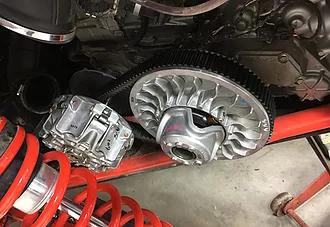CVT Tuning General Rules
Here are some general clutching rules you should play by!
- Primary clutch (Drive Clutch) = Front clutch off the motor
- Secondary Clutch (Driven Clutch) = Rear clutch connected to drivetrain
- Peak RPM = The RPM the machine sits and holds most of the time at WOT. This needs to be in your model's peak powerband for best results. (BMP supplies you with your optimum peak RPM when purchasing clutch kits)
- More Primary Clutch Weight = Less peak RPM & greater belt squeezing force
- Less Primary Clutch Weight = More Peak RPM & less belt squeezing force
- Primary Spring Starting Rate = Controls Engagement
- Stiffer Primary Spring Starting Rate = Higher engagement RPM
- Softer Primary Spring Stating Rate = Lower engagement RPM
- Primary Spring Ending Rate = Controls Up Shift, Back Shift & Peak RPM
- Stiffer Primary Spring Ending Rate = Slower Upshift, Quicker Backshift, More Peak RPM
- Softer Primary Spring Ending Rate = Faster Upshift, Slower Backshift, Less Peak RPM
- Steeper Helix Angle = Faster Upshift, Slower Backshift
- Shallower Helix Angle = Slower Upshift, Faster Backshift
- Stiffer Secondary Spring Finish Rate = Slower Upshift, Faster Backshift
- Softer Secondary Spring Finish Rate = Faster Upshift, Slower Backshift
Adding horsepower normally means you need to add clutch weight, go steeper on the helix angle, or both. Most small modifications only require adding clutch weight while larger horsepower modifications will require you to change both. Not changing clutching when you add horsepower will result in over-revving.
Credit to Bikeman Performance





